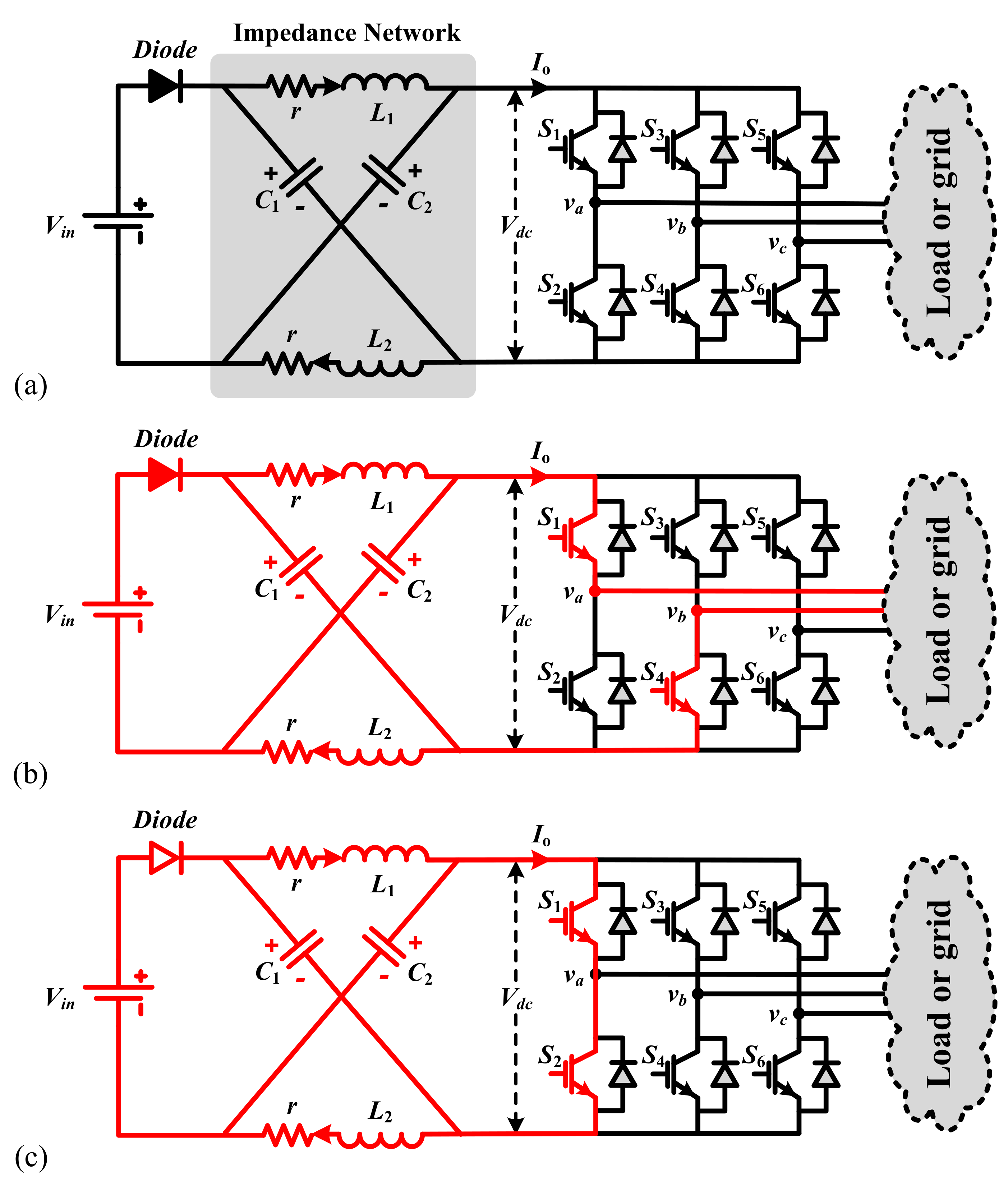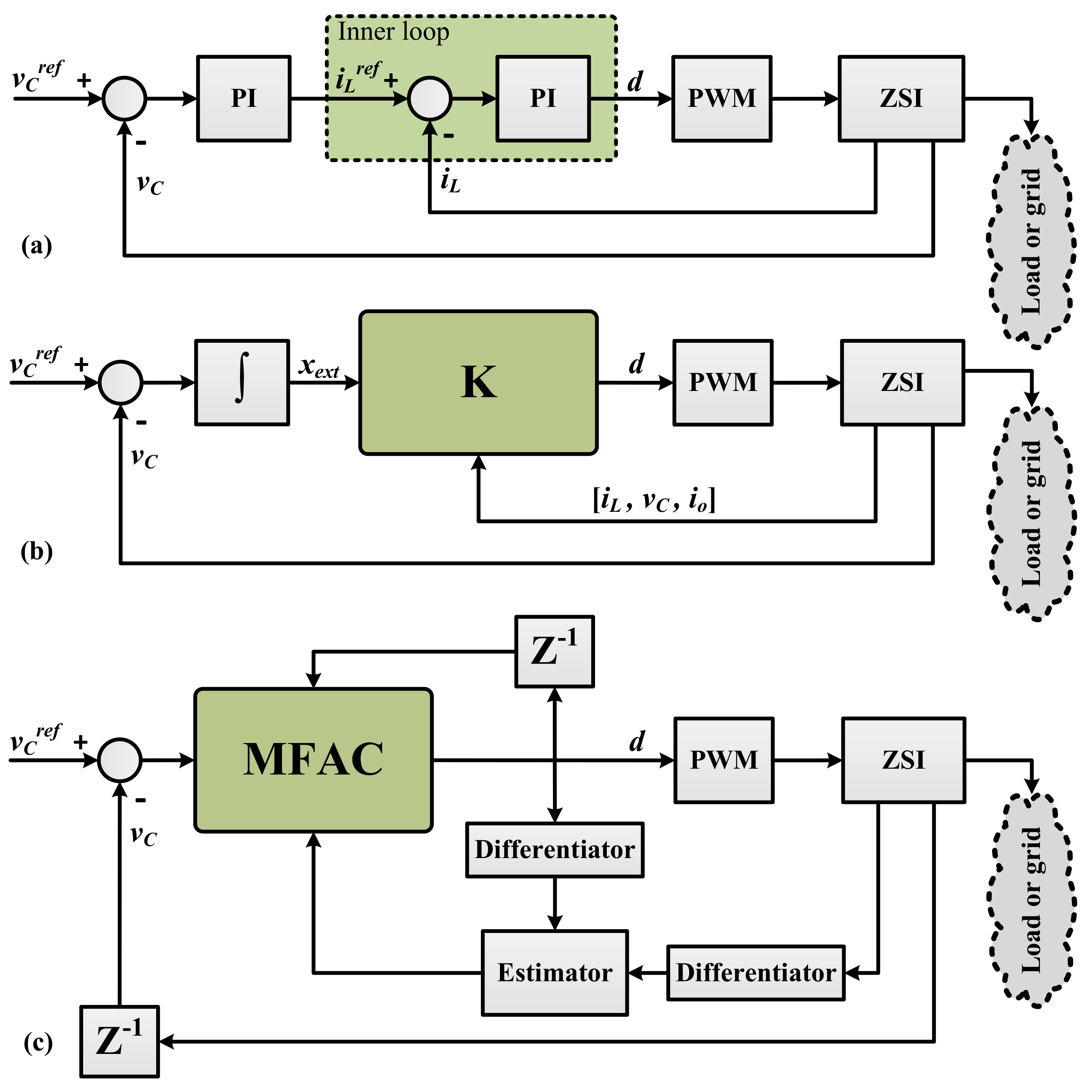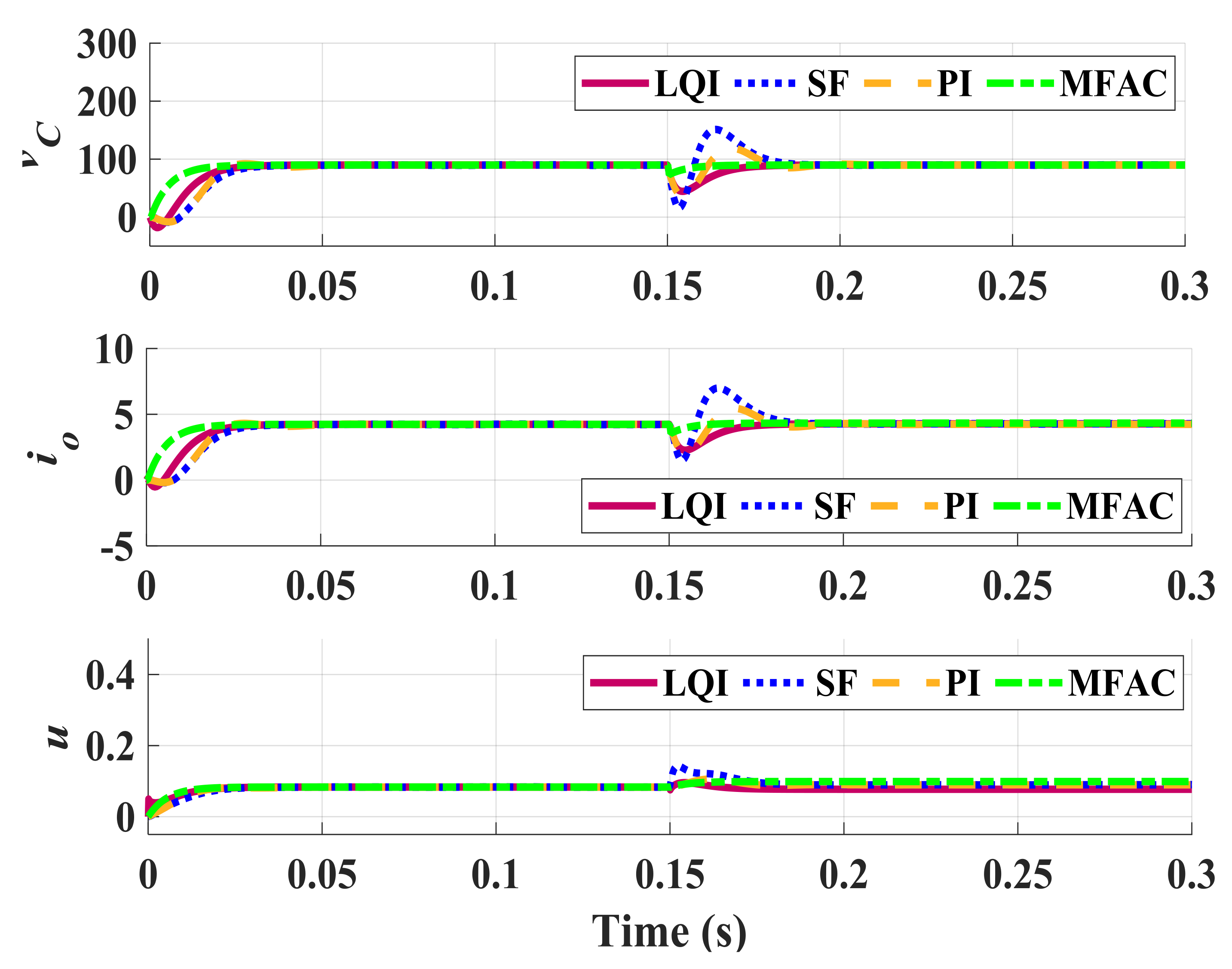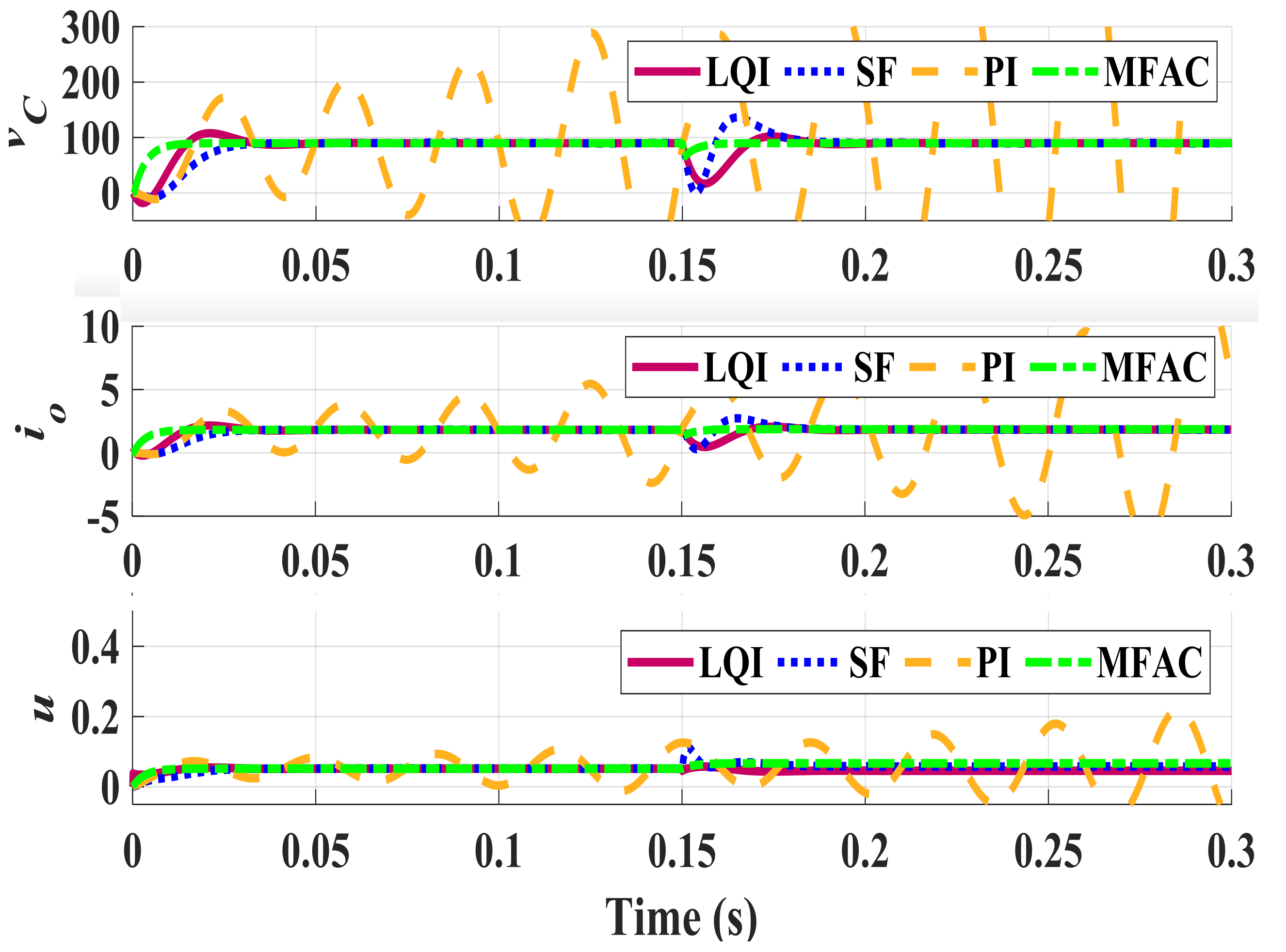Data-Driven Model-Free Adaptive Control of Z-Source Inverters
Abstract
:1. Introduction
2. Circuit Analysis
2.1. Shoot-Through Mode
2.2. Non-Shoot-Through Mode
3. The Proposed Controller
3.1. Algorithm of the Controller
3.2. Estimation Algorithm of PPD
3.3. Stability Analysis
4. Simulation Result
5. Conclusions
Author Contributions
Funding
Conflicts of Interest
References
- Babaie, M.; Sharifzadeh, M.; Kanaan, H.Y.; Al-Haddad, K. Switching-Based Optimized Sliding-Mode Control for Capacitor Self-Voltage Balancing Operation of Seven-Level PUC Inverter. IEEE Trans. Ind. Electron. 2020, 68, 3044–3057. [Google Scholar] [CrossRef]
- Taheri, S.; Jooshaki, M.; Moeini-Aghtaie, M. Long-term planning of integrated local energy systems using deep learning algorithms. Int. J. Electr. Power Energy Syst. 2021, 129, 106855. [Google Scholar] [CrossRef]
- Taheri, S.; Ghoraani, R.; Pasban, A.; Moeini-Aghtaie, M.; Safdarian, A. Stochastic framework for planning studies of energy systems: A case of EHs. IET Renew. Power Gener. 2020, 14, 435–444. [Google Scholar] [CrossRef]
- Zobaa, F.A.; Aleem, S.H.E.A.; Abdelaziz, A.Y. (Eds.) Classical and Recent Aspects of Power System Optimization; Academic Press: Cambridge, MA, USA, 2018. [Google Scholar]
- Chen, J.; Maksimovic, D.; Erickson, R. Analysis and design of a low-stress buck-boost converter in universal-input PFC applications. IEEE Trans. Power Electron. 2006, 21, 320–329. [Google Scholar] [CrossRef]
- Babaie, M.; Mehrasa, M.; Sharifzadeh, M.; Al-Haddad, K. Floating Weighting Factors ANN-MPC Based on Lyapunov Stability for Seven-Level Modified PUC Active Rectifier. IEEE Trans. Ind. Electron. 2021, 69, 387–398. [Google Scholar] [CrossRef]
- Liu, Y.; Abu-Rub, H.; Ge, B.; Blaabjerg, F.; Ellabban, O.; Loh, P.C. Impedance Source Power Electronic Converters; John Wiley & Sons: Hoboken, NJ, USA, 2016. [Google Scholar]
- Kojabadi, H.M.; Ebrahimi, R.; Esmaeilifard, H.; Chang, L.; Chen, Z.; Blaabjerg, F. High boost transformer-based Z-source inverter under continuous input current profile. IET Power Electron. 2019, 12, 3716–3723. [Google Scholar] [CrossRef]
- Estévez-Bén, A.A.; Tapia, H.J.C.L.; Carrillo-Serrano, R.V.; Rodríguez-Reséndiz, J.; Nava, N.V. A New Predictive Control Strategy for Multilevel Current-Source Inverter Grid-Connected. Electronics 2019, 8, 902. [Google Scholar] [CrossRef] [Green Version]
- Ge, B.; Abu-Rub, H.; Peng, F.Z.; Lei, Q.; Almeida, A.; Ferreira, F.J.T.E.; Sun, D.; Liu, Y. An Energy-Stored Quasi-Z-Source Inverter for Application to Photovoltaic Power System. IEEE Trans. Ind. Electron. 2012, 60, 4468–4481. [Google Scholar] [CrossRef]
- Ahmadi, A.; Mohammadi-Ivatloo, B.; Anvari-Moghaddam, A.; Marzband, M. Optimal Robust LQI Controller Design for Z-Source Inverters. Appl. Sci. 2020, 10, 7260. [Google Scholar] [CrossRef]
- Dehghan, S.M.; Mohamadian, M.; Yazdian, A. Hybrid Electric Vehicle Based on Bidirectional Z-Source Nine-Switch Inverter. IEEE Trans. Veh. Technol. 2010, 59, 2641–2653. [Google Scholar] [CrossRef]
- Liu, Y.; Ge, B.; Abu-Rub, H.; Peng, F.Z. An Effective Control Method for Quasi-Z-Source Cascade Multilevel Inverter-Based Grid-Tie Single-Phase Photovoltaic Power System. IEEE Trans. Ind. Inform. 2013, 10, 399–407. [Google Scholar] [CrossRef]
- Liu, J.; Jiang, S.; Cao, D.; Peng, F.Z. A Digital Current Control of Quasi-Z-Source Inverter with Battery. IEEE Trans. Ind. Informatics 2012, 9, 928–937. [Google Scholar] [CrossRef]
- Liu, Y.; Ge, B.; Abu-Rub, H.; Peng, F.Z. Control System Design of Battery-Assisted Quasi-Z-Source Inverter for Grid-Tie Photovoltaic Power Generation. IEEE Trans. Sustain. Energy 2013, 4, 994–1001. [Google Scholar] [CrossRef]
- Ayad, A.; Karamanakos, P.; Kennel, R. Direct Model Predictive Current Control Strategy of Quasi-Z-Source Inverters. IEEE Trans. Power Electron. 2016, 32, 5786–5801. [Google Scholar] [CrossRef]
- Iniyaval, P.; Karthikeyan, S.R. Fuzzy logic based quasi Z-source cascaded multilevel inverter with energy storage for photovoltaic power generation system. In Proceedings of the 2016 International Conference on Emerging Trends in Engineering, Technology and Science (ICETETS), Pudukkottai, India, 24–26 February 2016; pp. 1–5. [Google Scholar]
- Shinde, U.K.; Kadwane, S.G.; Gawande, S.; Reddy, M.J.B.; Mohanta, D.K. Sliding Mode Control of Single-Phase Grid-Connected Quasi-Z-Source Inverter. IEEE Access 2017, 5, 10232–10240. [Google Scholar] [CrossRef]
- Bagheri, F.; Komurcugil, H.; Kukrer, O.; Guler, N.; Bayhan, S. Multi-Input Multi-Output-Based Sliding-Mode Controller for Single-Phase Quasi-Z-Source Inverters. IEEE Trans. Ind. Electron. 2019, 67, 6439–6449. [Google Scholar] [CrossRef]
- Amirhossein, A.; Mohammadi, P.; Mohammadi-Ivatloo, B.; Amani, A.M. LMI-based robust controller design and implementation for Z-source inverters. IET Power Electron. 2020, 13, 4058–4067. [Google Scholar]
- Belila, A.; Berkouk, E.-M.; Benbouzid, M.; Amirat, Y.; Tabbache, B.; Mamoune, A. Control methodology and implementation of a Z-source inverter for a stand-alone photovoltaic-diesel generator-energy storage system microgrid. Electr. Power Syst. Res. 2020, 185, 106385. [Google Scholar] [CrossRef]
- Shuai, D.; Qianfan, Z. Analysis and Control of Current Ripples of Z-Source Inverters. IEEE Access 2020, 8, 41220–41228. [Google Scholar] [CrossRef]
- Mande, D.; Blondin, M.; Trovão, J.P.F. Optimisation of fractional-order PI controller for bidirectional quasi-Z-source inverter used for electric traction system. IET Electr. Syst. Transp. 2020, 10, 376–384. [Google Scholar] [CrossRef]
- Ghahderijani, M.M.; Dehkordi, B.M. Comprehensive Robust and Fast Control of Z-Source-Inverter-Based Interior Permanent Magnet Synchronous Motor Drive System. IEEE Trans. Ind. Electron. 2020, 68, 11783–11793. [Google Scholar] [CrossRef]
- Ahmadi, A.H.; Nikravesh, S.K.Y. A novel instantaneous exploitation based bat algorithm. In Proceedings of the 2016 24th Iranian Conference on Electrical Engineering (ICEE), Ghasro Dasht St, Iran, 10–12 May 2016; pp. 1751–1756. [Google Scholar]
- Ahmadi, A.H.; Nikravesh, S.K.; Amani, A.M. A Unified IMC based PI/PID Controller Tuning Approach for Time Delay Processes. AUT J. Electr. Eng. 2020, 52, 31–52. [Google Scholar]
- Ahmadi, A.H.; Nikravesh, S.K.Y. Robust Smith Predictor (RSP). In Proceedings of the 2016 24th Iranian Conference on Electrical Engineering (ICEE), Shiraz, Iran, 10–12 May 2016; pp. 1510–1515. [Google Scholar]
- Mohamed, E.; Aleem, S.H.E.A. Overview of uncertainties in modern power systems: Uncertainty models and methods. In Uncertainties in Modern Power Systems; Academic Press: Cambridge, MA, USA, 2020; pp. 1–34. [Google Scholar]
- Skelton, R.E. Model error concepts in control design. Int. J. Control 1989, 49, 1725–1753. [Google Scholar] [CrossRef]
- Van Helvoort, J.J.M. Unfalsified Control: Data-Driven Control Design for Performance Improvement; Technische Universiteit Eindhoven: Eindhoven, The Netherlands, 2007. [Google Scholar]
- Liu, J.; Lam, J.; Shen, M.; Shu, Z. Non-fragile multivariable PID controller design via system augmentation. Int. J. Syst. Sci. 2017, 48, 2168–2181. [Google Scholar] [CrossRef] [Green Version]
- Hou, Z.; Wang, Z. From model-based control to data-driven control: Survey, classification and perspective. Inf. Sci. 2013, 235, 3–35. [Google Scholar] [CrossRef]
- Dibaji, S.M.; Pirani, M.; Flamholz, D.B.; Annaswamy, A.M.; Johansson, K.H.; Chakrabortty, A. A systems and control perspective of CPS security. Annu. Rev. Control 2019, 47, 394–411. [Google Scholar] [CrossRef] [Green Version]
- Hou, Z.; Jin, S. Model Free Adaptive Control: Theory and Applications; CRC Press: Boca Raton, FL, USA, 2013. [Google Scholar]
- Zhang, F.; Kodituwakku, H.A.D.E.; Hines, J.W.; Coble, J. Multilayer data-driven cyber-attack detection system for industrial control systems based on network, system, and process data. IEEE Trans. Ind. Inform. 2019, 15, 4362–4369. [Google Scholar] [CrossRef]
- Hou, Z.S. The Parameter Identification, Adaptive Control and Model Free Learning Adaptive Control for Nonlinear Systems. Ph.D. Thesis, Northeastern University, Shenyang, China, 1994. [Google Scholar]
- Hou, Z.; Jin, S. A Novel Data-Driven Control Approach for a Class of Discrete-Time Nonlinear Systems. IEEE Trans. Control Syst. Technol. 2010, 19, 1549–1558. [Google Scholar] [CrossRef]
- Roman, R.; Radac, M.; Precup, R. Multi-input-multi-output system experimental validation of model-free control and virtual reference feedback tuning techniques. IET Control Theory Appl. 2016, 10, 1395–1403. [Google Scholar] [CrossRef] [Green Version]
- Xu, D.; Jiang, B.; Shi, P. A Novel Model-Free Adaptive Control Design for Multivariable Industrial Processes. IEEE Trans. Ind. Electron. 2014, 61, 6391–6398. [Google Scholar] [CrossRef]
- Liang, S.; Ye, C.; Xiong, Q.; Wang, Z.; Liu, T. Model-free adaptive control for microwave heating process with actuator saturation constraint. J. Microw. Power Electromagn. Energy 2019, 53, 81–93. [Google Scholar] [CrossRef]
- Siwakoti, Y.P.; Peng, F.Z.; Blaabjerg, F.; Loh, P.C.; Town, G.E. Impedance Source Network for Electric Power Conversion Part I: A Topological Review. IEEE Trans. Power Electron. 2015, 30, 699–716. [Google Scholar] [CrossRef]
- Shen, M.; Peng, F.Z. Operation modes and characteristics of the Z-source inverter with small inductance. In Proceedings of the Fourtieth IAS Annual Meeting. Conference Record of the 2005 Industry Applications Conference, Hong Kong, China, 2–6 October 2005; Volume 2, pp. 1253–1260. [Google Scholar]






| Parameter | Symbol | Value |
|---|---|---|
| Input voltage (V) | 20 | |
| Shoot-through duty cycle | D | |
| Capacitor voltage (V) | ||
| Inductor current (A) | ||
| Output current (A) | ||
| Capacitor (F) | C | |
| Inductor (mH) | L | |
| Coupling inductor (mH) | ||
| Load () | 27 | |
| Parasitic resistance () | r | |
| Switching frequency (KHz) | f | 10 |
| Servo Response | Regulatory Response | ||||
|---|---|---|---|---|---|
| Controller | TV | IAE | MP(%) | IAE | Peak |
| LQI | 0.095 | 1.325 | 0 | 0.637 | 0 |
| SF | 0.083 | 1.562 | 0 | 26.456 | 62.027 |
| PI | 0.128 | 1.505 | 1.984 | 27.054 | 29.195 |
| MFAC | 0.016 | 0.869 | 0 | 0.112 | 0 |
| Servo Response | Regulatory Response | ||||
|---|---|---|---|---|---|
| Controller | TV | IAE | MP(%) | IAE | Peak |
| LQI | 0.066 | 1.656 | 0 | 1.197 | 0 |
| SF | 0.092 | 2.055 | 0 | 25.720 | 48.990 |
| PI | 0.968 | 10.256 | 72.331 | 8.651 | 106.560 |
| MFAC | 0.116 | 1.481 | 0 | 0.991 | 0 |
| Servo Response | Regulatory Response | ||||
|---|---|---|---|---|---|
| Controller | TV | IAE | MP(%) | IAE | Peak |
| LQI | 0.142 | 0.982 | 0 | 0.432 | 0 |
| SF | 0.120 | 1.409 | 0 | 2.999 | 195.893 |
| PI | 0.161 | 2.144 | 0 | 0.724 | 36.837 |
| MFAC | 0.116 | 0.123 | 0 | 0.157 | 0 |
Publisher’s Note: MDPI stays neutral with regard to jurisdictional claims in published maps and institutional affiliations. |
© 2021 by the authors. Licensee MDPI, Basel, Switzerland. This article is an open access article distributed under the terms and conditions of the Creative Commons Attribution (CC BY) license (https://creativecommons.org/licenses/by/4.0/).
Share and Cite
Asadi, Y.; Ahmadi, A.; Mohammadi, S.; Amani, A.M.; Marzband, M.; Mohammadi-ivatloo, B. Data-Driven Model-Free Adaptive Control of Z-Source Inverters. Sensors 2021, 21, 7438. https://doi.org/10.3390/s21227438
Asadi Y, Ahmadi A, Mohammadi S, Amani AM, Marzband M, Mohammadi-ivatloo B. Data-Driven Model-Free Adaptive Control of Z-Source Inverters. Sensors. 2021; 21(22):7438. https://doi.org/10.3390/s21227438
Chicago/Turabian StyleAsadi, Yasin, Amirhossein Ahmadi, Sasan Mohammadi, Ali Moradi Amani, Mousa Marzband, and Behnam Mohammadi-ivatloo. 2021. "Data-Driven Model-Free Adaptive Control of Z-Source Inverters" Sensors 21, no. 22: 7438. https://doi.org/10.3390/s21227438
APA StyleAsadi, Y., Ahmadi, A., Mohammadi, S., Amani, A. M., Marzband, M., & Mohammadi-ivatloo, B. (2021). Data-Driven Model-Free Adaptive Control of Z-Source Inverters. Sensors, 21(22), 7438. https://doi.org/10.3390/s21227438









